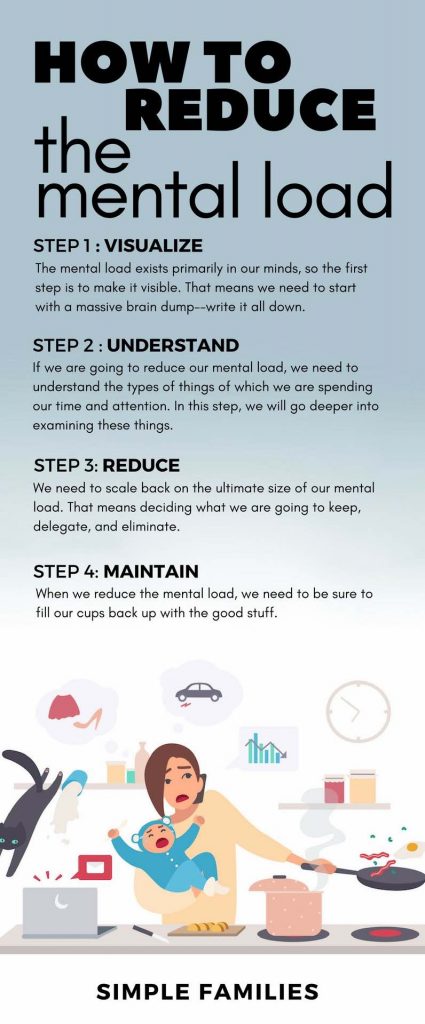
Do you ever wash the sheets?
It was the question that started it all. One day while making the bed my husband casually and unassumingly asked me, “do you ever wash the sheets?”. You see, my husband doesn’t see me wash the sheets. He leaves early in the morning and comes back late at night.
I work from home and take care of our young children, so I do the laundry during the day. When it’s time to wash the sheets, I strip the bed, wash them, then put them back into place.
It’s almost like it never happened.
Kind of magic, really.
My brain has become adept at running our home and family like a well-oiled machine. This machine often works the magic of making it all look like it never happened. Planning it all, remembering it all, knowing it all, and worrying about it all–all within the confines of one tired, overworked brain.
Thus is the invisible mental load of motherhood.
There are many days when I feel as if my brain may explode. I must keep a constant supply of clean underwear in the drawers, a stash of emergency snacks in my purse, and ensure flu shots are administered before the peak of the season is upon us.
I do all this while trying to sustain some semblance of a career, sanity, and toned arms.
The Plan: How to Reduce the Mental Load
The mental load of it all consumed me. So I made a plan.
I knew I needed to wrangle my exploding brain and get a handle on this motherhood journey (of which I have only skimmed the surface). I am going to keep this simple, because if you are still reading I am going to take a wild guess that you are also blessed with a very capable, yet nearly-exploding brain. So here’s how I reduced the mental load in four steps.
WANT TO DO IT TOGETHER? JOIN US STARTING FEBRUARY 27TH TO REDUCE THE MENTAL LOAD. CLICK HERE!
Step 1: Visualize
The vast majority of the mental load is invisible. It’s the planning, worrying, researching, and anticipating that consumes our minds. Therefore, the first step is to make it visible. That means, take everything out of your head and put it onto paper. I took the mental load out of my head and turned it into a pile of note cards. Each card earned a separate piece of the mental load.
- Anticipate when we will run out of toothpaste.
- Ensure that children use the toothpaste.
- Make sure that Crest doesn’t cause cancer.
You get the drift. Every notecard holds a piece of the larger mental load. When executing this massive brain dump, I was stunned at how much of the mental load was invisible even to me. The sheer amount of material that a parent considers, processes, and executes each day is astounding.
It’s no wonder that we feel stressed out, right?
Step 2: Understand
Once the brain dump is complete, I worked to develop a better understanding of it all. I sorted and divided my mental load into three categories: planning, worrying, executing. This helped me to better understand where I was putting most of my energy and time.
- Be sure everyone has an extra blanket in case the night gets cold
- Remember to bring extra shirt for the baby when we eat Italian food.
- Make sure the big kid pees before we leave the house.
Step 3. Reduce
Reduction was also a three-part sorting process: keep it, delegate it, or eliminate it. There were many no-brainers that I had to “keep” in my mental load, like packing lunches. The kids have to eat, right?
I’ve always struggled with asking for help and delegating. My husband is very helpful with the kids and our family, but he thrives when he knows exactly what he needs to be doing. So by handing off a physical piece of my mental load to him (i.e. a handful of cards) he appreciated having it all in written down.
The best part of this process was elimination–which was the biggest way I reduced my mental load. I became aware of plans, worries, and actions that weren’t necessary and weren’t serving me. Tossing those into the trash–once and for all–felt great.
Step 4. Maintain
Whenever we make big changes, it’s important that we stick with them. Reducing the mental load is vital, but also replacing many of those thoughts and worries with healthy alternatives is also necessary. I am on the journey to find a consistent mindfulness practice–dabbling in yoga, meditation, and generally just being completely present with my family.
Motherhood is a gift and I want to enjoy it as much as possible. That means reducing my mental load so that I can focus on being exactly the woman, wife, and mama that I want to be.
WANT TO DO IT TOGETHER? JOIN US STARTING FEBRUARY 27TH TO REDUCE THE MENTAL LOAD. CLICK HERE!
Like it? Pin it.

